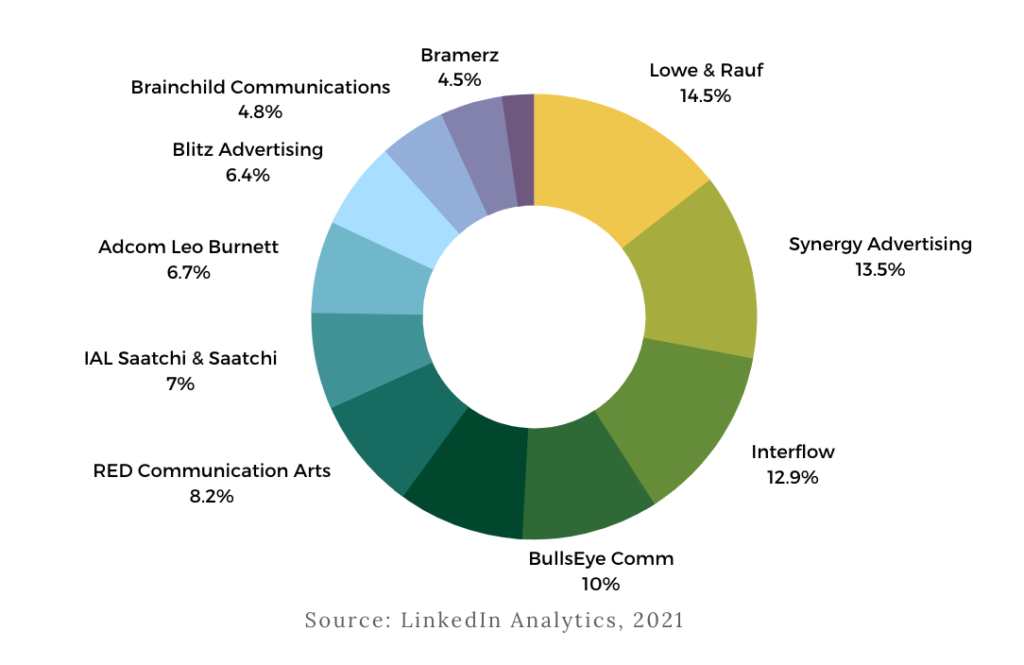It’s that time of the year. As advertising agencies across Pakistan gear up to pitch for one of the largest media reviews in the country, an internal value proposition assessment is revealing the flaws in talent management and retention strategies. Across GroupM, Z2C Limited, Adcom, Synergy Advertising, and others, top talent with decades of experience has been leaving in droves over the past year, with the departure of Sarwar Khan at Maxus seemingly nuking the camel’s back.
Chief among the reasons for leaving are immigration to Australia or Canada, better salaries, a clear career progression, learning opportunities, and the prestige of joining the client-side. While there is little an advertising agency can do to retain talent on the brink of immigrating to what they think are greener pastures, there is possibly much they can do in the face of monetary compensation or reward structures and merit-based cultural reengineering.
According to data from LinkedIn Insights, the top advertising agencies in Pakistan – be it creative, digital, or media – ranked by the average tenure of employees are
- Lowe & Rauf at 9.3 years
- Synergy Advertising at 8.7 years
- Interflow Communications at 8.3 years
- BullsEye Communication at 6.4 years
- Orientm McCann Pakistan at 5.9 years
- RED Communication Arts at 5.3 years
- IAL Saatchi & Saatchi at 4.5 years
- Adcom Leo Burnett at 4.3 years
- Blitz Advertising at 4.1 years
- Brainchild Communications Pakistan at 3.1 years
- Bramerz at 2.9 years
- BBDO Pakistan at 1.5 years
A comparative analysis pitting all Pakistan-based agencies of GroupM against Z2C Limited found that the average tenure of a GroupM employee across Mindshare, Mediacom, Wavemaker, Xaxis, and MEC was nearly 44 months which is 19% better than the average tenure of an employee of Z2C Limited across Starcom Pakistan, Blitz Advertising, Starcrest Communication, Brainchild Communications Pakistan, MHoldings, and PakMediaCom.

These numbers are still less than the apparent six average year tenure from the 12 listed advertising agencies mentioned above, with media predominantly taking the largest slice of the promotion services budgets of the advertiser, evidenced by a ranking based on taxes paid.
To understand all the reasons executives are leaving the advertising function, we spoke with several marketers on the client-side and on the agency to document and highlight the chief variables compelling a break.
A lack of flexibility
“People were always leaving their workplaces in search of better opportunities,” said Mehwish Aslam, the current project manager for bSecure and former media leader at Spark SMG and Starcom MediaVest Group. “Any reasonable employee plans to switch simply because the workplace has become redundant. There is little to no opportunity for learning. The new normal of WFH has opened doors to a bigger workforce, especially comprising women, who initially were reluctant to step out due to their home duties.”
She told Profit that young adults are sharp, street smart, and restless. Much like industrialists that are unwilling to evolve unless an unseen force shatters their kneecaps for investing all resources in one basket, human resources professionals are seemingly uninterested in evolving the variables that makeup company culture and facets of motivation.
“Flexibility is the key to survival,” said Aslam. “Targets should be short term, evaluations should be quarterly and bi-annually, recognition and increments should be with it. This generation is too fickle to wait a year for results. I feel this would help the employer decide if the resources they are using to train an employee are worth it. It helps the employee’s see their progress more
frequently and feel a bit more motivated.”
She added that an actual open-door policy – not one that exists for PR points – including frequent surveys of managers – including top management – and a suggestion box will surely help too. She said doing so would create three outcomes: a workforce
- which is on their toes to meet their targets because rewards are instant.
- who gets frequent feedback and hence has a chance to make improvements.
- who doesn’t feel that employees are sitting on their butts playing PUBG
And added that at the end of the day, employers can see instant progress and are able to pick out their most productive employees and hence spend more time and effort to keep them motivated.

“I have seen agencies appreciating late sittings & on-time finishing work or going home is considered a big question mark on one’s performance,” said Sundus Shahid, a digital marketing manager at SpurSol. “There is a lot of 11th-hour work, with crucial deadlines along with other exhausting practices with close to none focus on individual’s well-being which sooner or later pushes the employee at the verge of either being dull & non-productive or worse, leaving the place.”
The death of meaningful work
Speaking with Naureen Awais, the general manager of human resources at GroupM, Profit sought a reverse exit interview perspective to understand why top talent is joining the organization as of late and what she has gauged are the reasons for the big switch.
“The biggest motivation to come and join GroupM is to learn more,’ she said. “So obviously when it comes to the organizations and local agencies that are working as competitors to GroupM – yes they do provide opportunities [in the form of] much faster growth within the organization in terms of being promoted or salary increases, but in terms of learning they are not as good as GroupM.”
She said that as the only multinational media investment business in Pakistan, GroupM has access to a lot of global learning which she says is missing out in other agencies, adding that the basic motivation for joining GroupM is training and development adding that regional assignments and the knowledge sharing from the region itself nourish the employee experience.
“I feel agencies are now failing to enrich talent experience,” said Rizwan Merchant, the founder, and CEO of M2 Pakistan, a media auditing firm. “Fresh talent requires continuous attention and engagement which agencies are failing at especially with traditional mediums other than digital. The seth owned agencies are focused on making money through any means necessary hence continuous instructions are coming from the top management whereas the other agencies are just working in the same rut. On one hand, fresh talent is ambitious yet impatient on the other agencies are hiring herds thinking a few might stick around basically running on the same old model of hiring trainees attracting them through higher salaries and other benefits.

He told Profit that by its nature, the world of media agencies works around the clock and is a reality that all stakeholders – employees, clients, channels – should come to terms with. He said results should matter and should be prioritized over vain measures of performance and loyalty such as time spent in the office or filling out timesheets. The ability to manage work – at any location – should be what matters, nothing else, he said.
“I just saw [an episode of] ID Comms [where they discussed] the new Wavemaker launch of media planning artificial intelligence,” said Merchant. “We did that back in 2012 when we managed RB at OMD. Our plans were automated which allowed a quick turnaround for media plans and more focus on analytical thinking, execution, and deliverables. Fresh MBAs require analytical challenges not the dog work of managing data on excel and software. As the agencies understand brand audiences they need to understand their own [internal] audience and what they need to retain it.”
He added that the relationship between advertisers and agencies needs an F5 intervention, as the former faces changing audience habits while the latter is unwilling or unable to deliver a solution that delivers the wow factor.
“For example, I clicked on Cadbury’s static ad on a website which took me to Youtube to show the same ad which they are running on television,” he said. “If I am clicking a digital ad it means I am interested in buying the product or getting engaged with the brand in one way or the other. Showing me the same ad as on television will not achieve anything. The point is that if agencies continue to deliver such solutions how do you expect them to retain fresh talent despite their clients facing new challenges with the audience.”
Piling on, Brandverse co-founder Raza Matin told Profit that advertising agencies – be it activation, creative, media, or digital – have no point of differentiation. The former marketing consultant for Google lamented that across the board you find the same talent, business models, and channels.
“You are in the business of selling rice, and complaining about not getting credit for the dish that Aylanto put out using it,” he said. “Why do people not transition from brand to agency until their tail end of their career, if at all? Agencies in Pakistan are in the outsourcing business, not in the value addition business. No different than the janitorial services or security guards company you contract out to. If you are unable to quantify the value that you provide as an agency, you will forever be resigned to playing the subservient service provider, who hopes to retain retainers, whilst fighting the inevitable race to the bottom in terms of commissions.”

He said that any business whose output has been commoditized – as has media – will pay people commodity prices for talent, which is why they don’t stick around, eventually migrating to markets where they are able to do the same work, for more money, because the agencies there have figured out how to articulate, calculate and quantify the business value they provide to their clients.
“Ten years ago, when graduating from Indus Valley, I chose [the] advertising industry,” said Tehmina Fatima, the creative director of Manhattan International. “The main reason for being in this field was for the thrill of seeing my concepts, ideas, and design executed for the world to see. Another reason for being in advertising was the fact that I have the chance to create something that can influence a mindset and hopefully change it for the better.”
Speaking to Profit, Fatima expressed apprehension that when she does marry and start a new chapter in her life, the people around her will assume she cannot give it her all as the industry expects its employees to be available all the time, which is a mindset she wants to be changed.
“Agencies need to stop glamorizing the workaholic life and if they want to retain females in their company, regardless of their relationship status, they need to create boundaries and promote a healthier work-life balance.”
Casual misogyny
In the past decade, nearly 100 universities across Pakistan have introduced undergraduate programs in media sciences, the fine arts, media journalism, advertising, and more skills desired by the advertising industry. And yet, with half of all graduates representing women, LinkedIn analytics shows that on average women make up less than 30% of the workforce at the advertising agencies listed above and their SME counterparts.
In light of cultural expectations, women that get the chance to gain an undergraduate education are either engaged or married by the time they graduate and expected to deliver khush khabri within the next year. And in this time, four years of undergraduate education do not – contrary to what some may think – magically disappear, nor does the desire to work in the profession of one’s training.

For the women placed in the above scenario, the absence of flexible work from home initiatives from advertising agencies across the activation, creative, media, or digital spectrum sends a very clear message: we are not willing to win you over. Ironically, the decision-makers against WFH are the same people that immigrate to Australia or Canada to work in firms with nearly a 50-50 male-to-female workforce due to flexible arrangements for both genders.
In the same vein that the failure to recognize the importance of testing a user interface with a range of races is a path towards frictionless user experiences, it is the lack of consideration towards the stronger sex that creates an atmosphere that hasn’t taken the time to craft a human capital strategy for women at various stages of their personal lives. And of the women that do end up joining the workforce, there’s the expectation silently accepting decades of being undermined.
“My mind has always raced, from business numbers to recoveries, to team management and client expectations,” said Mariyem Abdi, a senior brand manager at Tapmad. “With over ten years of experience in the industry, I have found that criticism of the work that you do is fundamentally based on gender. Male-dominant management will sweep your ideas, and opinions under the rug, and that is what I believe forces female professionals to leave advertising.”
She told Profit that women start off by taking these instances as a challenge, but when they realize the same idea by a male employee is well perceived and, in fact, holds greater value, that is where women begin to lose motivation and just focus on getting the work out rather than putting in the effort to reshape values. She said that talent thrives in a culture where they are challenged and appreciated not mentally dissected or undermined.
“Statistically, historically you would find more women in advertising than men, but those are just optics,” said Amina Baig, head of operations at East River. “You will find a lot of those women struggle to keep up with the hours. So, let’s assume 20 to 30 percent of these women will eventually be forced to leave for easier hours. I will sidestep this and tell you that almost all these women put in a full workday and still work once they’re home – but unlike their male counterparts, their work is not seen, hence not considered. Optics.”
She told Profit that married women are often dismissed as useful unless they prove their worth by working twice as many hours as everyone else while new mothers are doubly dismissed as their first priority is never assumed to be their job.

“If the employers are supportive and flexible, colleagues and subordinates may think you just got lucky in some mysterious way which involves zero hard work,” she said. “The best employers will think a few times before offering you more responsibility, or a promotion, or balk at your ‘ridiculous’ requests for flexible hours.”
She lamented that at the end of the day, week, or a couple of years, most women tire of this dance. This can be fixed, she said, by setting standards and procedures that can streamline the workflow. She suggests introducing precedents with clients so they know your agency will work in a certain order and still deliver, adding that while this shift will take time, it is in her experience doable.
“No one is saying no to the twice or three times a month all-nighters or the shoot that never ends, but a month full of nothing but those hours would burn anyone out, regardless of gender, “ said Baig. “Yes, we understand what advertising requires us to do. It’s grueling work. It’s crazy. It’s heartbreaking in every way. But we love it. That’s why we’re here. Make it a little easier for us. And for your male employees. And yourselves.”
She concluded that advertising is roundly pushing everyone out, not just women, adding that the industry needs to revisit how it works otherwise the trend of high employee turnovers means that neither the agency nor employees nor clients are gaining the solid, lasting understanding that leads to good relationships and great collaborations.


























Hi Babar,
1. super confused about the chart with %ages on it – what is that? Is it the %age of women in the agency based on people work info from LI?
2. I think one of the biggest reasons why people quit is missing from this altogether –
people dont quite companies, people quit bosses. I think the lack of leadership development is one of the biggest reasons for people leaving the industry – too often people who do the job well are promoted to leadership levels in agencies without any leadership development initiatives in place, these great workers become horrendous bosses driving everyone out.
Thank you, Ali. You are correct, it does often boil down to the supervisor and how toxic or incompetent they are at servant leadership. We will address this in the follow up article which focuses on the largest WPP media agency. As for the chart, it’s the market share of talent retention effectiveness, which would admittedly worked better as a bar chart on further reflection.